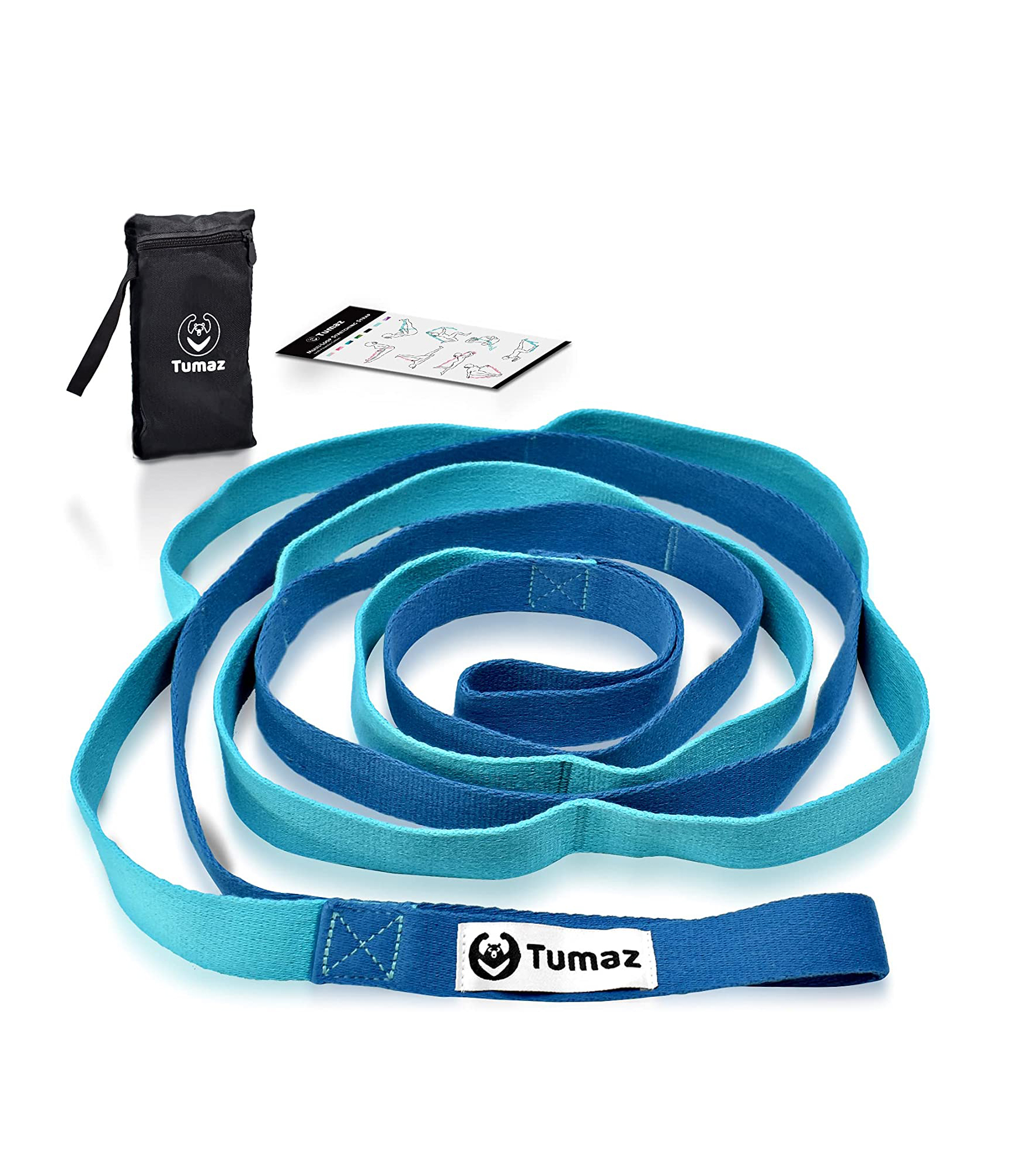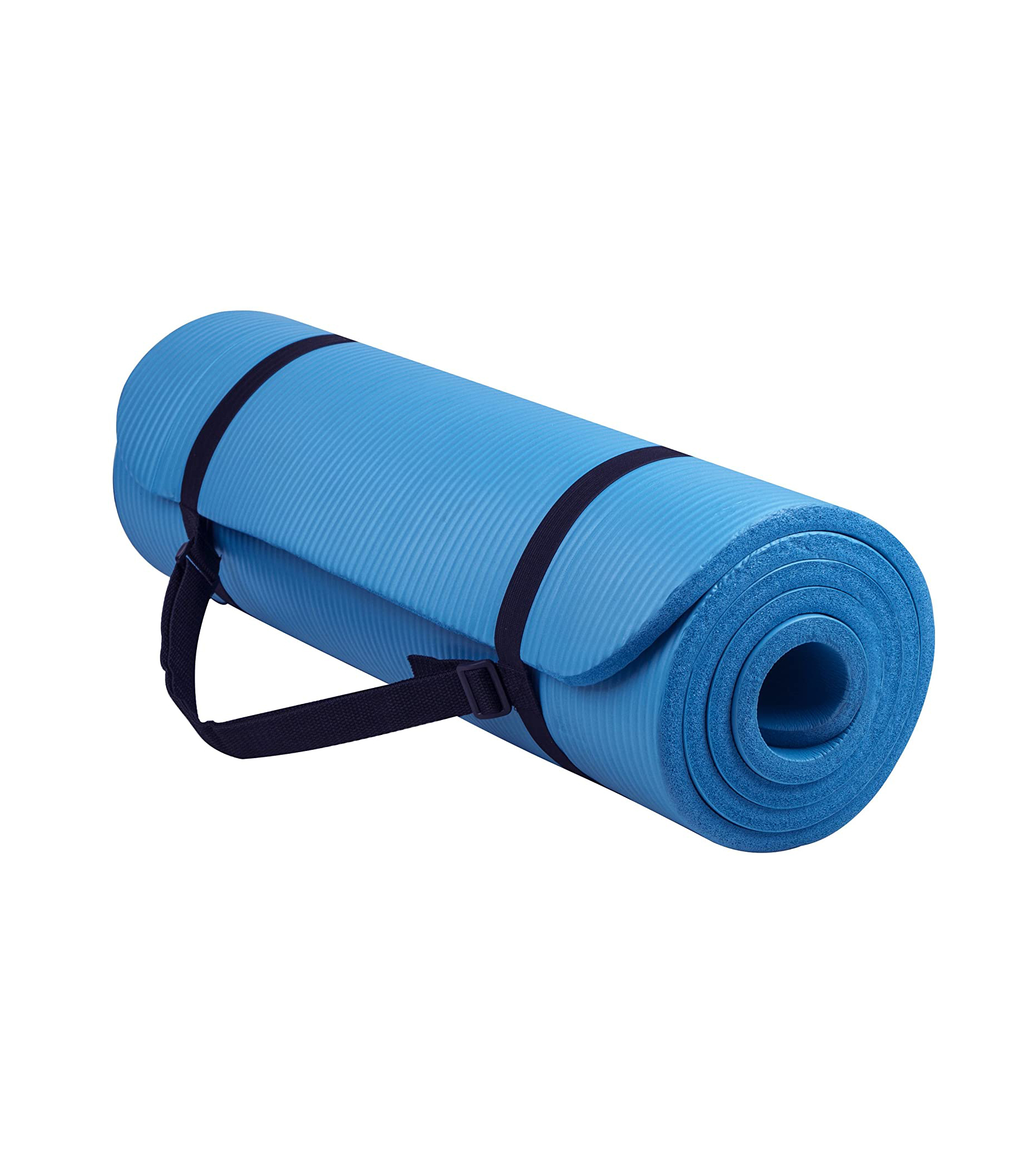These Stretches Can Make Your Body Feel So Much Better
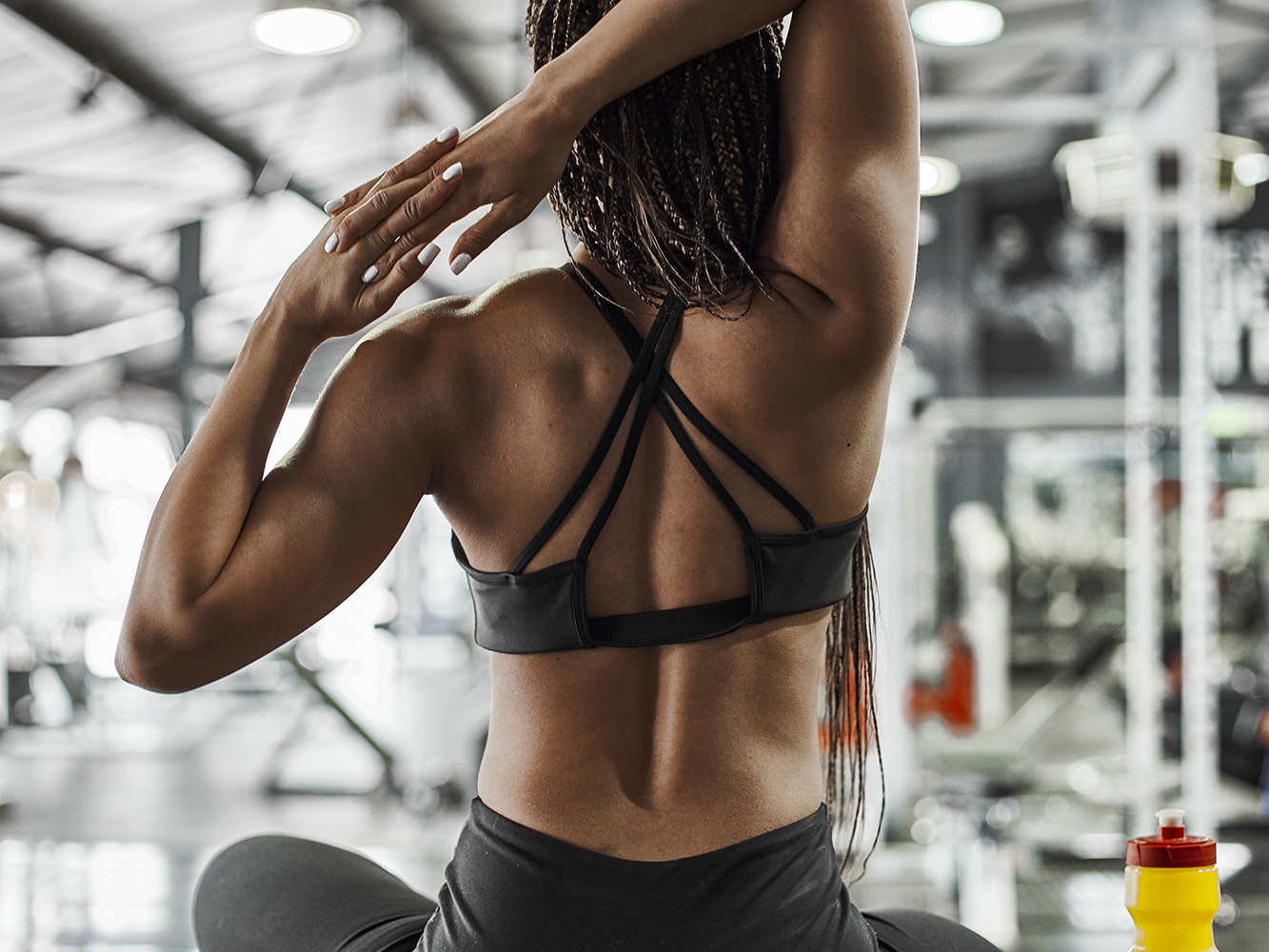
Stretching is so important, not just for pre- and post-workout, but also for your daily routine. According to Harvard Health, "Stretching keeps the muscles flexible, strong, and healthy, and we need that flexibility to maintain a range of motion in the joints. Without it, the muscles shorten and become tight. Then, when you call on the muscles for activity, they are weak and unable to extend all the way. That puts you at risk for joint pain, strains, and muscle damage."
So yeah, it's important, but how often do you actually do it? We might prioritize exercise a few times a week, but I think a lot of us forget to add the stretching part, or do just a few quick ones after a workout and call it a day. I know I'm guilty of that. The good news is we do some stretching throughout the day just by existing, pretty much. "Technically, we stretch every day whether we realize it or not! Every time you reach for something, or bend over, or look behind you, you're stretching! You're using your mobility," explains Patricia Sabulis, a MIRROR trainer.
But it's important to carve out some time for mindful stretching. "The CDC recommends stretching the entire body two to three times a week," says Jasmine "Jaz" Graham, a graduate of the Institute for Integrative Nutrition and certified personal trainer. "With so many people working from home and sitting for extended periods of time in chairs that are not ergonomically correct, stretching for a few minutes daily is helpful." If you can't do it every day just yet, Sabulis recommends starting with 10 minutes twice a week and then noticing how your body feels after a week or two. If it feels good, you can always add more sessions.
One easy way to get started is to do it right now. Yes, right now. "Any time you think of stretching a part of your body, do it," suggests Dani Schenone, RYT, ACSM-CPT, a holistic wellness specialist at Mindbody. "It's that simple. We often put things off because we think we have to make it a 'thing' and put all this effort into it. We don't have to make it complicated. We simply can make stretching a part of our everyday."
And the great thing about stretching is that you can easily incorporate it into your daily activities. Schenone says if you're waiting for water to boil, stretch your legs using the counter or a chair as a resting surface. Or, if you're working at your desk, set a phone alarm to stretch your arms, trunk, and spine every few hours. "You can even stretch in your bed! I find bed stretching to be a great way for people of all abilities to incorporate stretching into their routines," she says.
Take a look at some stretches to try below:
Stretches for Flexibility
1. Head Stretch
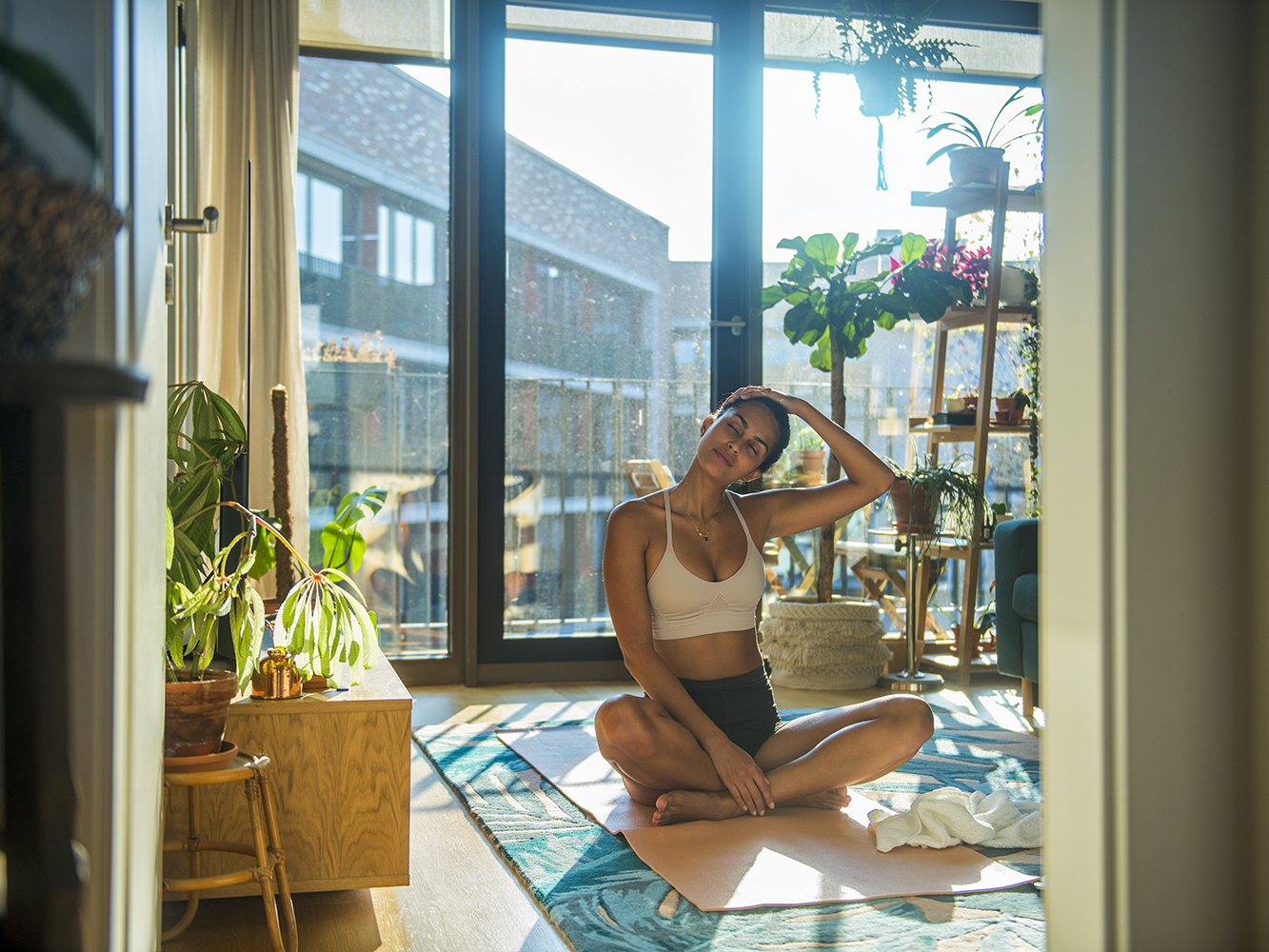
You can do this either sitting or standing up, says Graham.
Instructions: Place your right hand gently on top of your head and tilt your head to the right, lowering ear to shoulder. Repeat on the left side.
2. Forward Fold
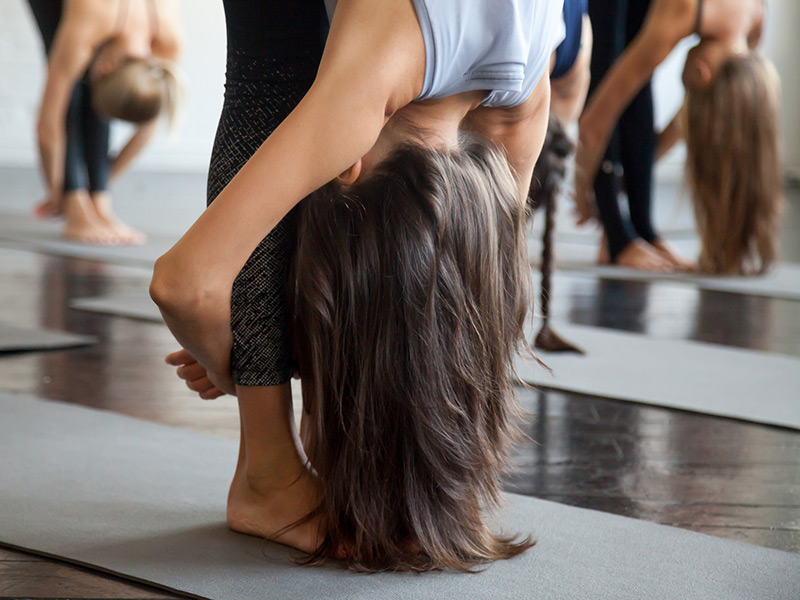
This stretch targets the glutes, hamstrings, calves, traps, rhomboids, lats, and erector spinae muscles, says Schenone. And it helps stimulate the liver and kidneys; strengthens the thighs; stretches the posterior side body; and decompresses the spine.
Instructions: Stand with your feet hips-width apart. Roll down your spine until you are hinged at the hips and your upper torso is handing towards the floor. Bend your knees as much as you need to so that you can experience a gentle stretch in your back. Depending on your hamstring flexibility, you may also feel this in your hamstrings. The more you bend your knees, however, the less you'll feel that tug in your hamstrings. Flexing your spine and rounding it forward is a great way to release tension in the lower back after standing or sitting all day.
3. Seated Wide-Legged Forward Fold
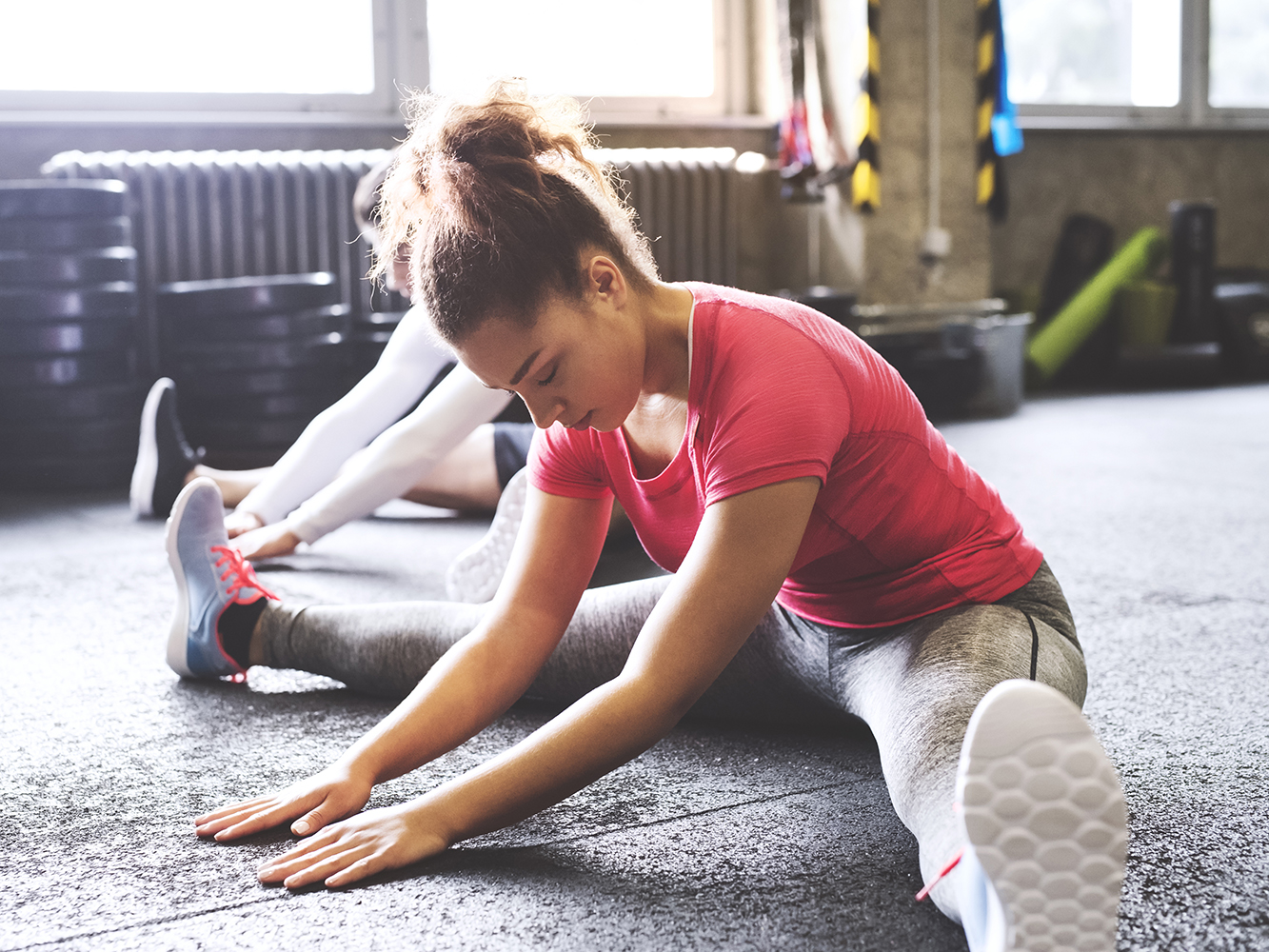
This seated stretch targets the hamstrings, calves, hips, low back, and inner legs. According to Schenone, it opens the hips; relaxes the upper back, extends the inner leg muscles, and helps relieve gas.
Instructions: In a seated position, lengthen your legs out as wide as they can go. Flex the feet. Place your hands directly in front of you, walking them away from your center until you find a nice stretch in the groin area.
4. Crossbody Shoulder Stretch
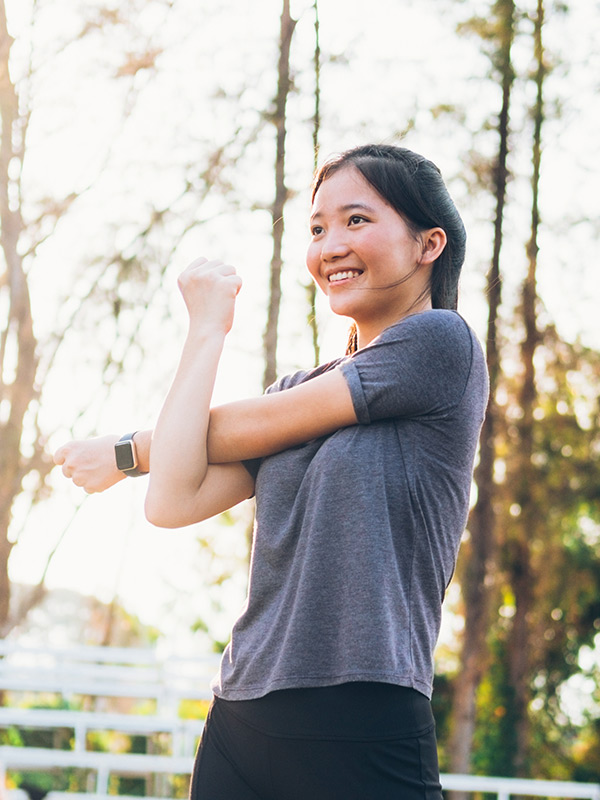
Graham says this is a great stretch for the back and shoulders.
Instructions: Reach your right arm across your body as the left arm cradles the right at elbow, pulling arm toward chest.
5. Seated Twists
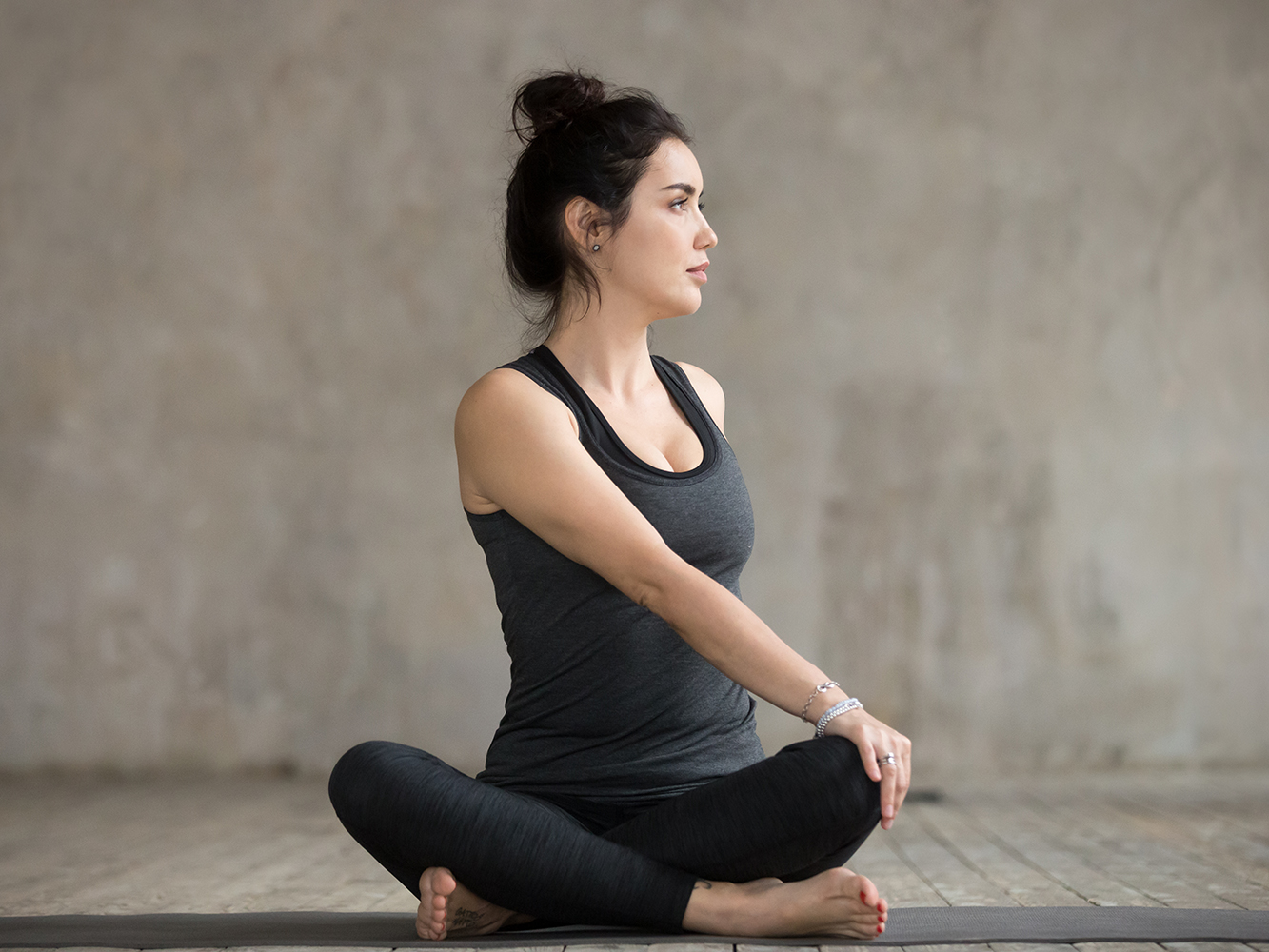
"These twists stretch and strengthen the muscles surrounding the spine and can help improve posture and relieve back tension," Sabulis says.
Instructions: Sitting in a cross-legged position, stretch your arms overhead and sit up as tall as you can. If you can't sit tall and lift your chest, sit on a pillow or chair instead. Once you stretch up tall, twist your body to the right. Cross your left arm towards your right leg. It can rest on the knee or thigh. Simultaneously, swing your right arm behind you either placing the hand to the floor behind your low back or place your right palm directly on your low back, fingers facing the floor. Inhale to think about lengthening tall and exhale to twist from your core. Stay for a few breaths and then come back through the center and take it to the other side.
6. Half Hero's Pose
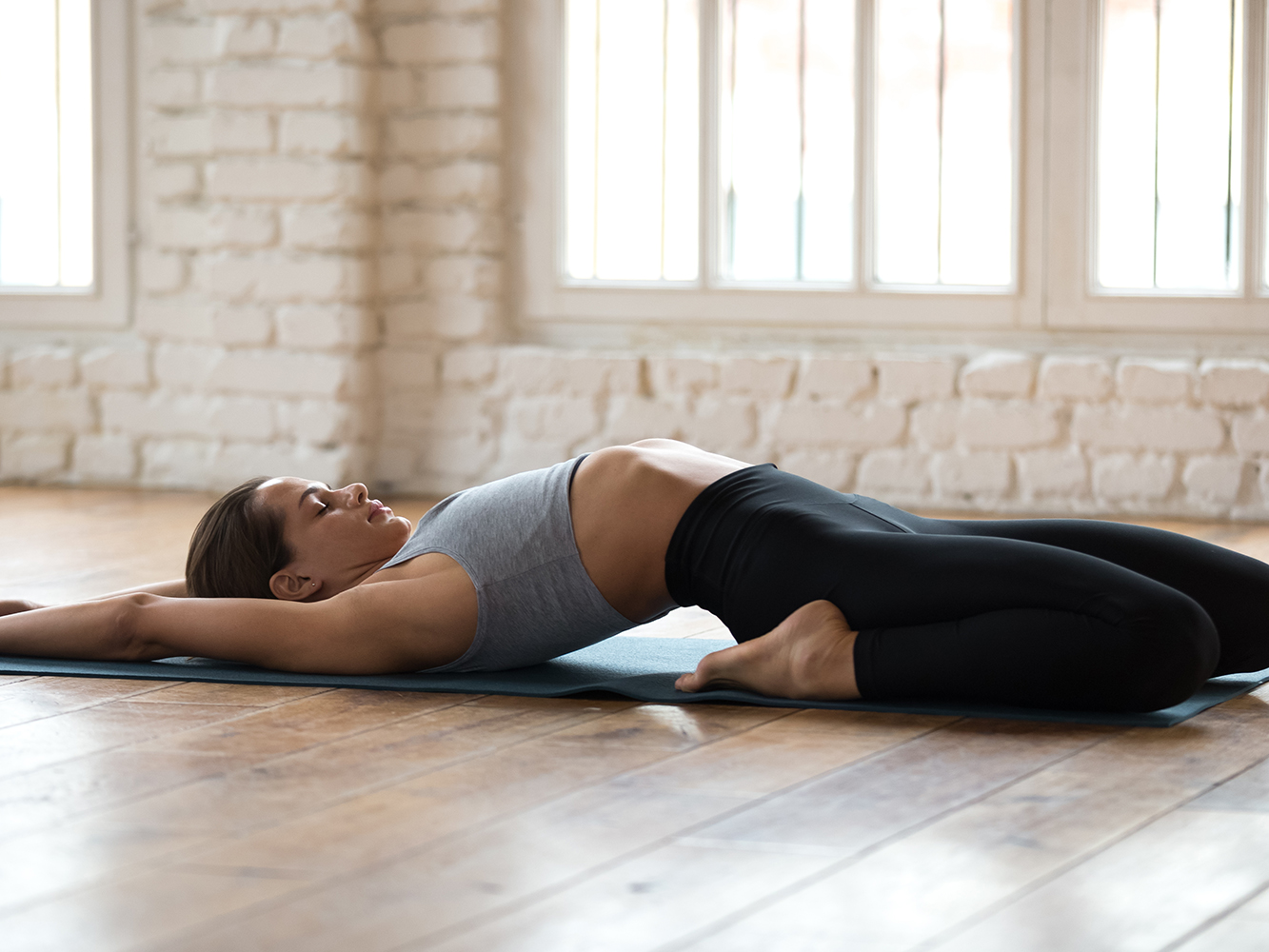
Schenone says that this stretch targets the quadriceps, all hip flexors, ankles, and feet. The movement stretches the anterior side body, reduces leg swelling, and increases knee flexibility.
Instructions: From a seated position with legs lengthened out long in front of you, sit to the side and bend your knee so that your foot rests beside your hip. Keep your torso tall or place your hands behind you. You may be able to come onto your forearms or back. Hold for 10-60 seconds. Switch sides.
7. Reclined Figure-Four Stretch
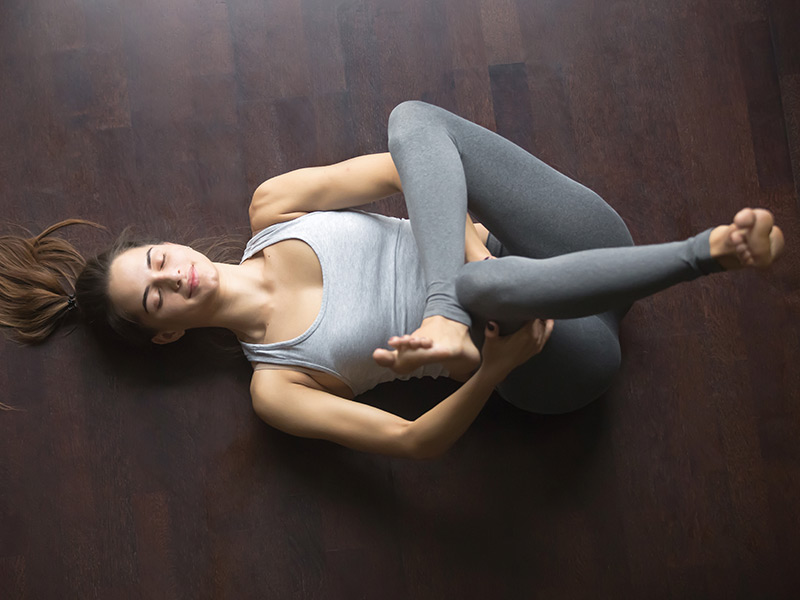
Graham says this stretch improves flexibility in the piriformis, hips, glutes, and quads.
Instructions: Laying on the floor, bend knees with feet on the floor. Cross your right ankle over your left quad creating the number four. Intertwine fingers around your left quad, under the right ankle, and pull toward your chest.
8. Runner's Stretch or Half Split
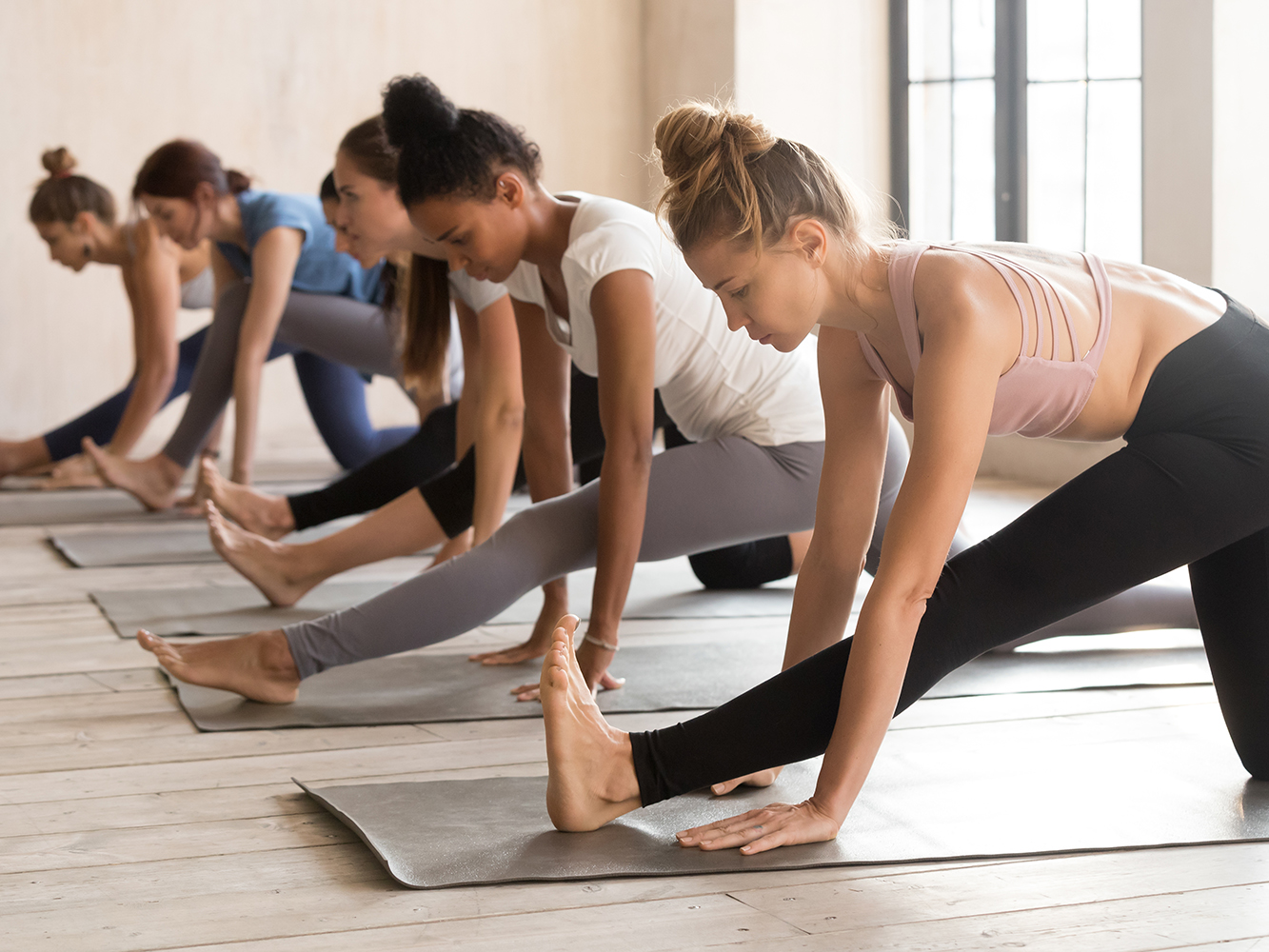
"Tight hamstrings can lead to pulling on the hips and low back," explains Sabulis. "Spending time stretching the backs of your legs will help with your range of motion and spine and hip flexibility."
Instructions: Kneeling on the floor, stretch one leg out in front of you and place the heel to the floor. Keep the other leg bent with the hip stacked over the knee. Place hands framing the extended leg. If you feel that your spine is very rounded and your pelvis tucked, place your hands on yoga blocks or bring them to your thigh (this will make it slightly trickier to balance so be careful). Without moving your hips, imagine your tailbone, or the base of your spine, reaching back toward your back heel and your chest reaching forward creating the feeling of a flat back. With this feeling of a long spine, gently hinge at the hip and lean forward until you feel a stretch in your hamstring. If you'd like to intensify this stretch, flex your toes, or keep the hinge in the hips and let just the upper spine round toward the leg. Do both sides.
9. Supine Spinal Twists
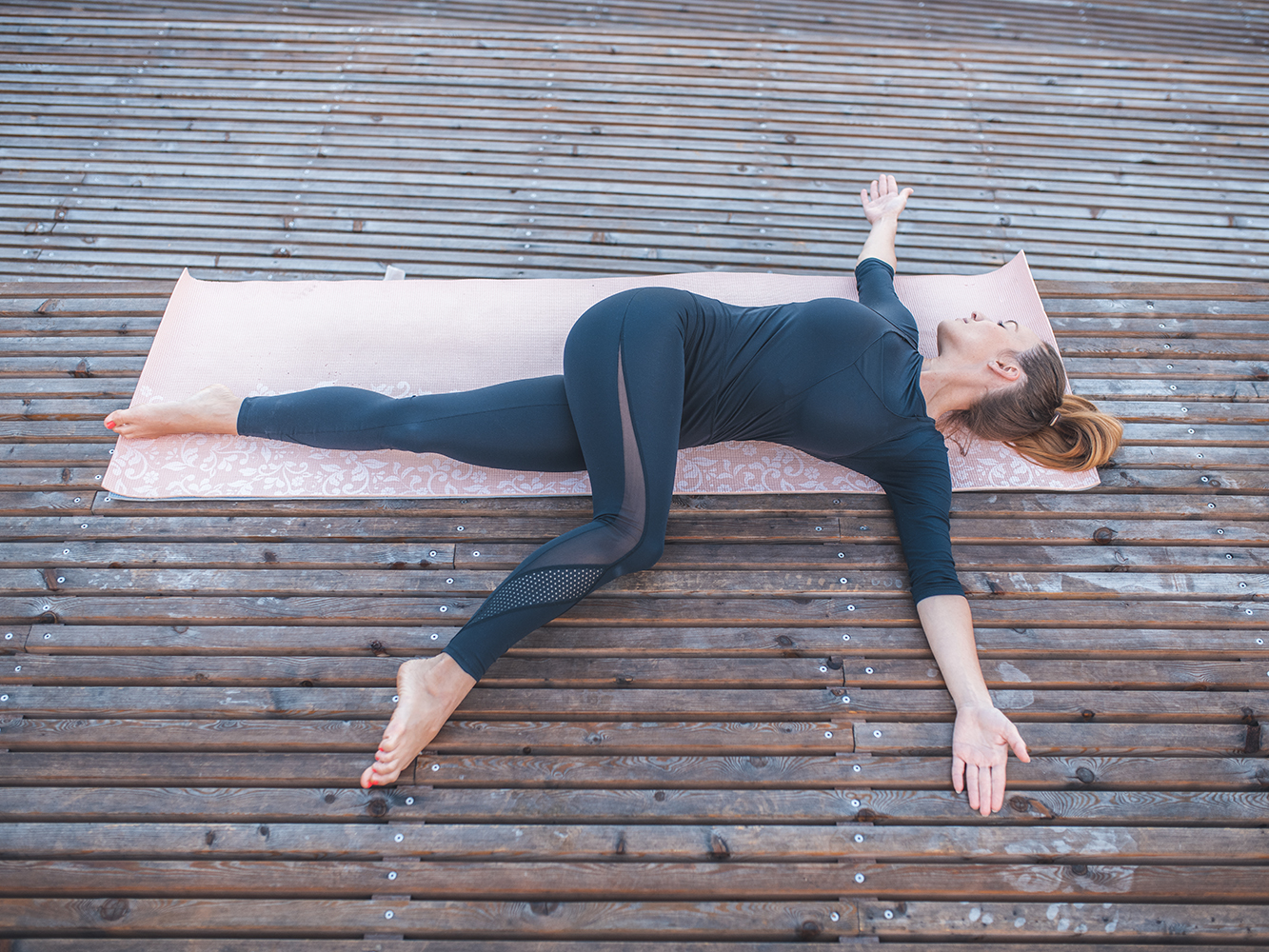
This twist targets the neck muscles, pecs, obliques, and gluteus maximus. Schenone says it promotes digestion, increases spinal mobility, and is restorative.
Instructions: While lying down, bring your shins parallel to the sky with your arms in a T. Drop the knees to the right, letting your right hand rest atop the right knee. The left shoulder softens down. Gaze to the left. Hold for 10-60 seconds. Switch sides.
10. Lower Back Knees to Chest Stretch
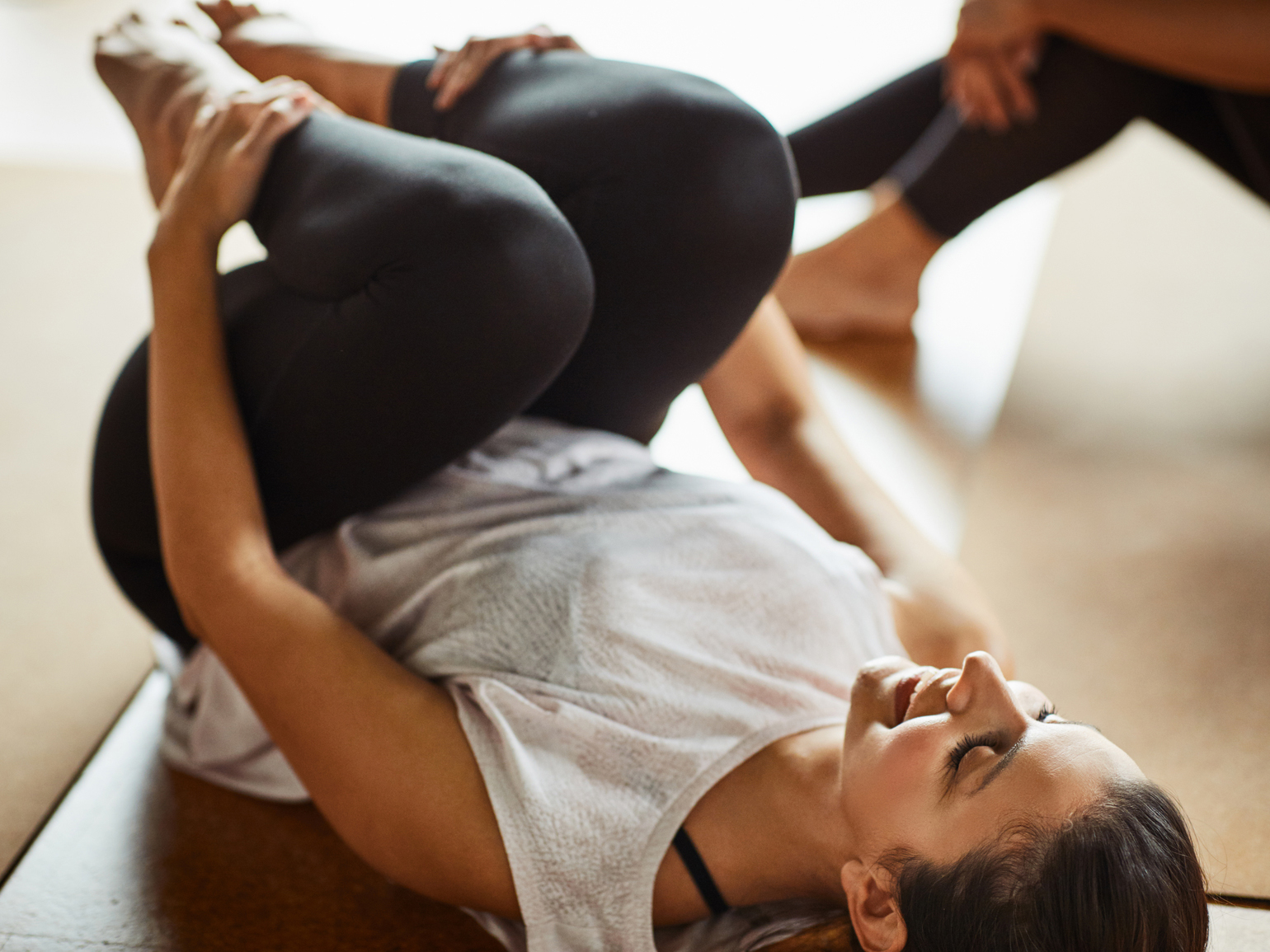
Graham says this stretch releases the lower back muscles and increases flexibility.
Instructions: Laying on the floor, bring both knees to chest, wrapping arms around legs with shoulder off the floor, curled into a ball-like position. Rock back and forth and side to side.
11. Quad Stretch on the Floor
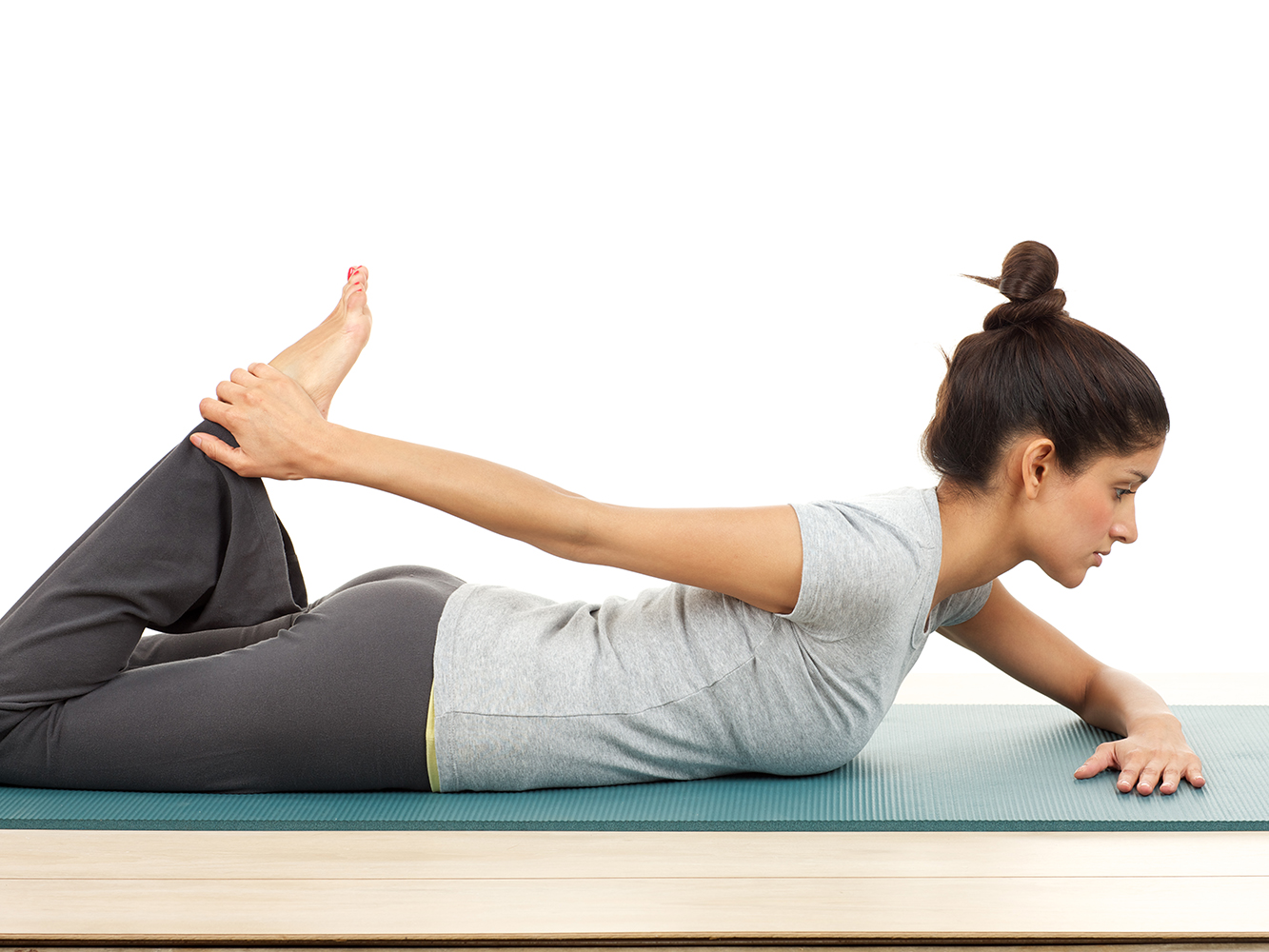
Stretching your thighs will ease tension on your knees and groin and help your range of motion in your legs and hips," Sabulis says.
Instructions: Lying face down on the floor, turn your head to one side (Bonus: this is a great neck stretch). Keeping your thighs on the floor, bend the knee of the leg you're looking toward. Kick the heel toward your buttocks. This already might feel like a stretch in the front of your thigh. If so, you can stop there. If you can, grab the top of the foot with the same arm. Keeping the thigh flat on the floor, gently pull the foot straight in toward the glute. Think about both hips staying grounded on the floor and breathe.
12. 90/90 Stretch
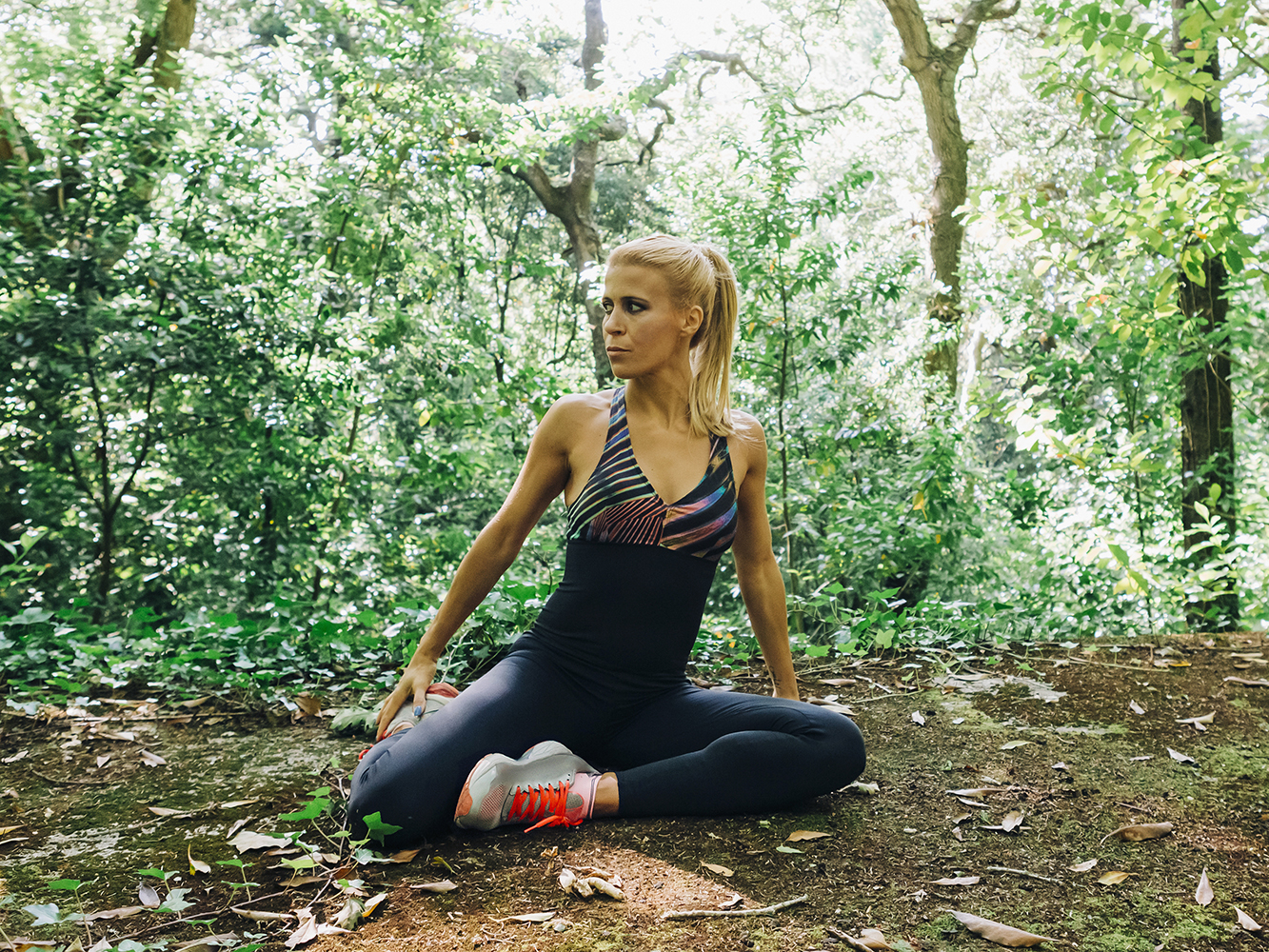
This stretch is very effective when attempting to loosen up hip flexors, according to Graham.
Instructions: Begin in a seated upright position with knees bent and feet on the floor. Rotate both knees to the floor, on the right side, creating a 90-degree angle. Once completed, repeat the same movement to the left. Keep chest lifted with a neutral spine.
13. Shoulder Clasp
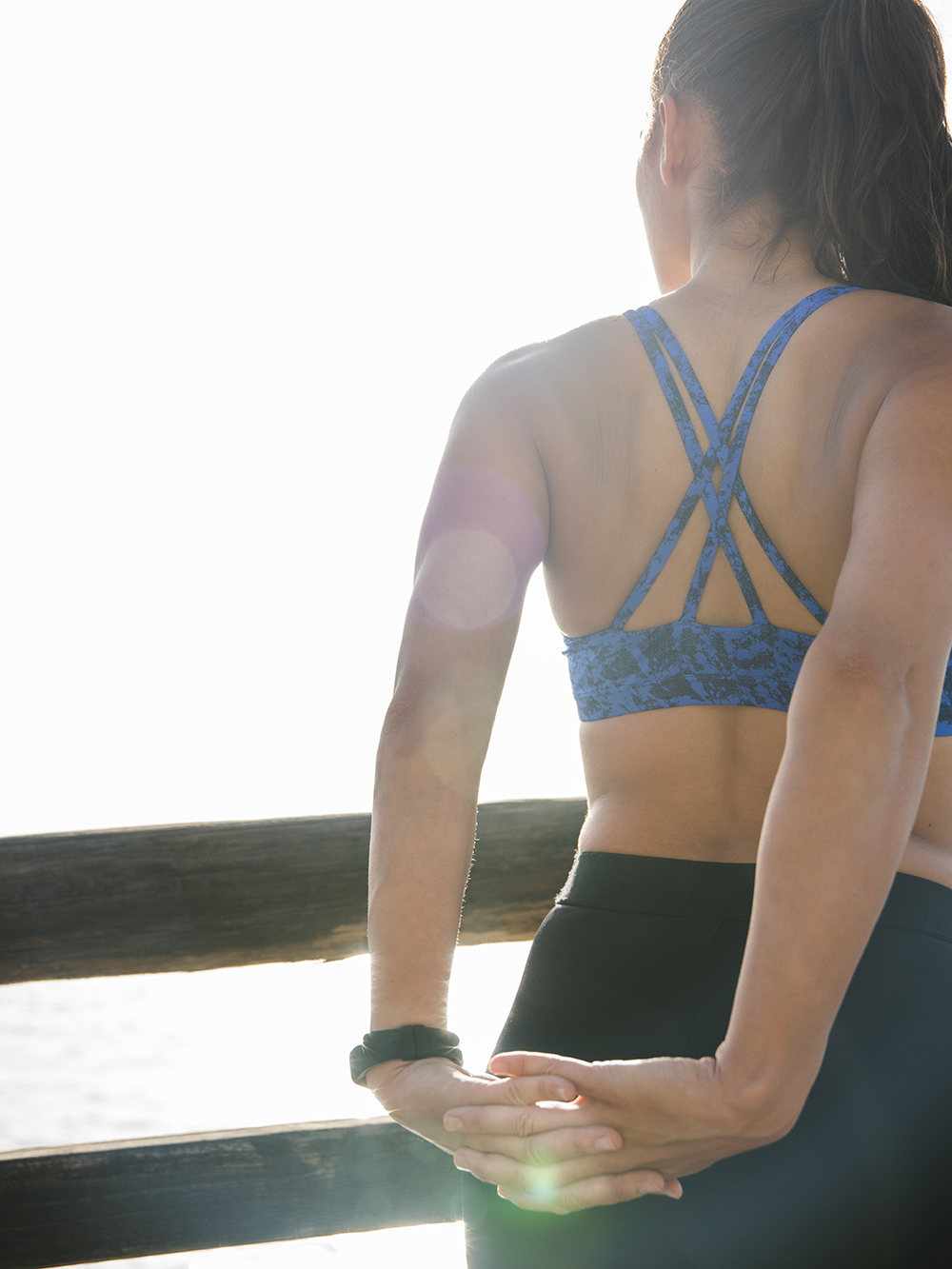
Schenone says this stretch targets the anterior deltoid, biceps, and pecs. It opens the chest, combats poor posture, relieves shoulder pain, and aids in shoulder mobility.
Instructions: From a standing position, clasp your hands behind your back. Open the chest as you pull your hands downward. Maybe you let your spine extend backwards, looking skyward.
14. Baby Cobra into Swan
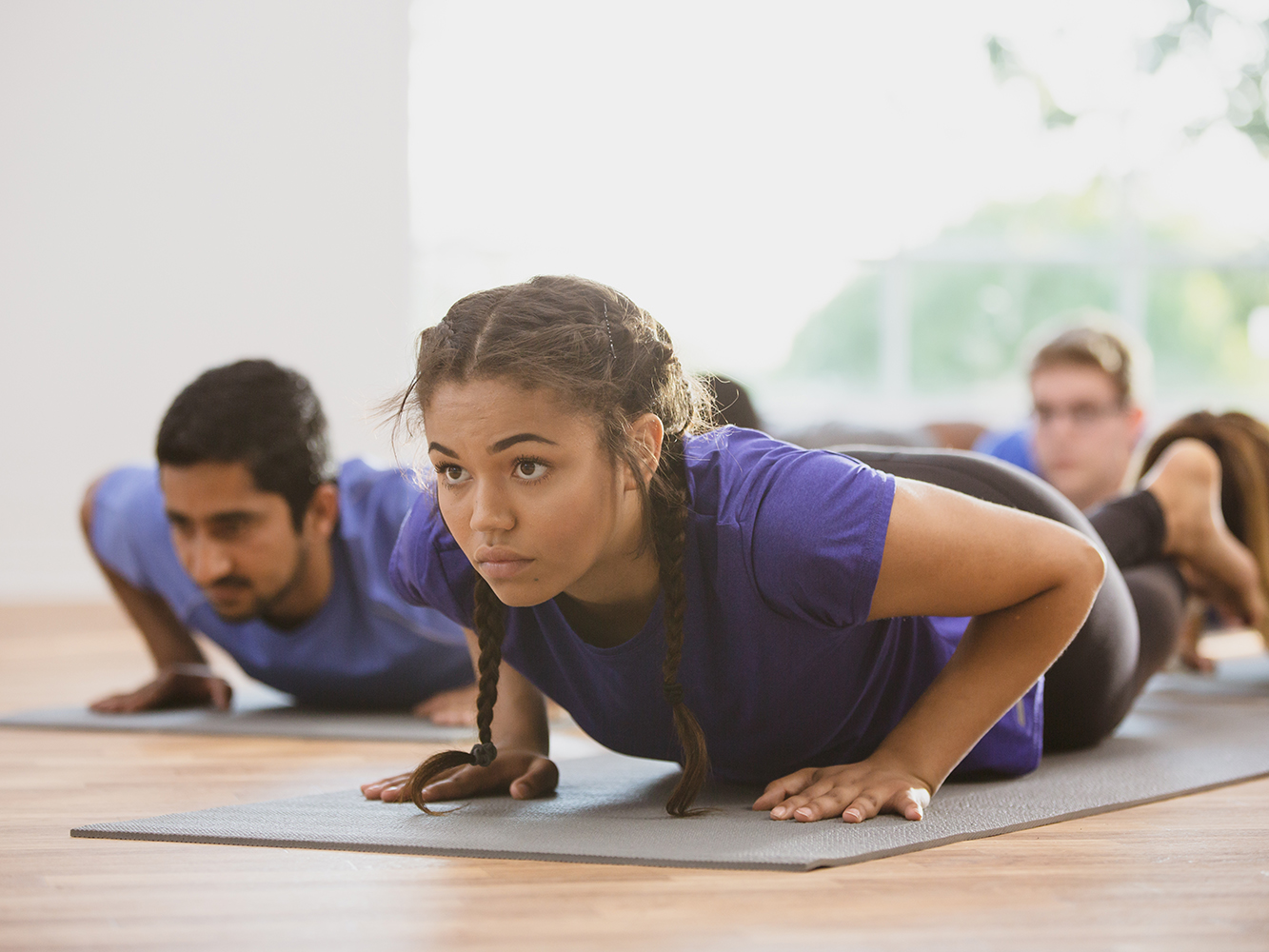
"Extending the spine helps to strengthen the muscles that surround it. It stretches the chest and shoulders and upper spine which helps with posture," Sabulis says.
Instructions: Lying face down on the floor, either chin or forehead to the floor (depending on how your neck feels). Place two palms down under your shoulders with your elbows pointing to the ceiling. Keeping your legs long behind you, separate them about hips-width apart with the tops of the feet on the ground. Keeping your feet on the floor, draw the navel to the spine, and try lifting the chest a few inches with barely any weight in the hands. This helps strengthen your middle and upper back and your core. Lift on an inhale, lower on an exhale. After three to five times, come up again, but this time use your hands and press your chest a little higher away from the ground until you feel a stretch in the front of your torso. Keep your hips on the floor and the shoulders down away from the ears. Come down slow and gentle. Repeat.
15. Butterfly Stretch
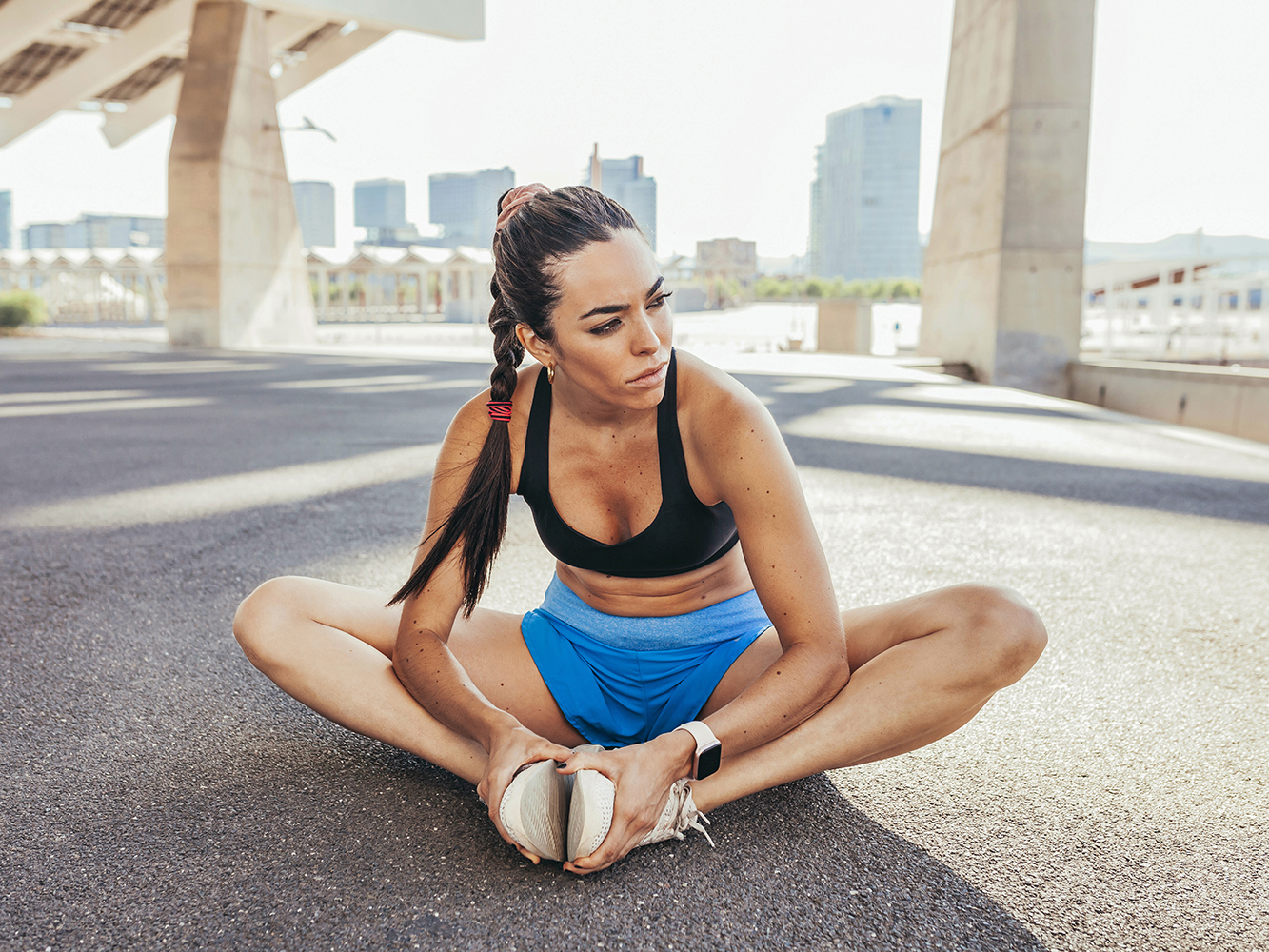
Graham says this stretch targets the adductors, groin, inner thighs, and lower back.
Instructions: Begin in a seated upright position with soles of feet together and knees bent. Holding on to the ankles, engage your core and lower yourself toward your feet as you lower knees toward the floor.
16. Side Stretch
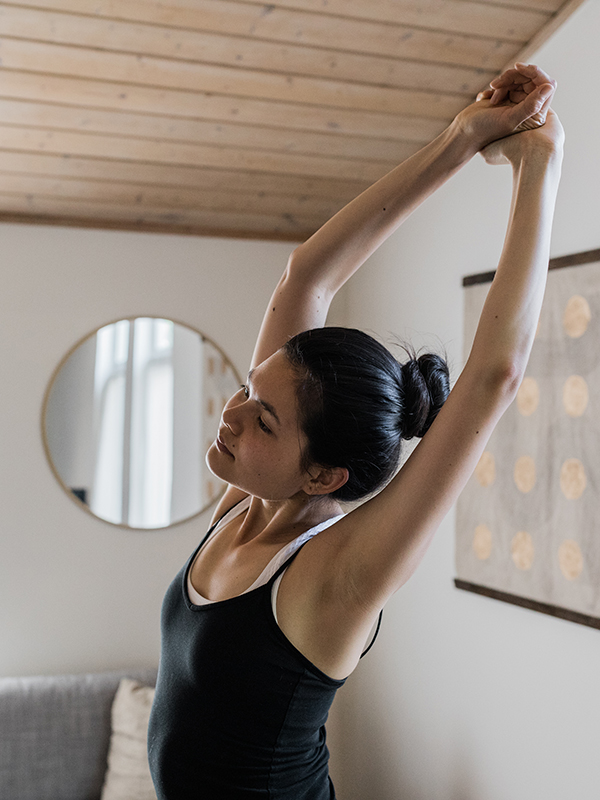
Schenone says this stretch targets the neck muscles, rhomboids, obliques, glutes, quadratus lumborum, and intercostal muscles. It aids in trunk support; regulates digestion and elimination; and strengthens the spine.
Instructions: From a standing position, lift your hands skyward and grab onto your right wrist, leaning to the left. Hold for 10-60 seconds. Switch sides.
Do's and Don'ts of Stretching
While stretching is beneficial for pretty much everyone, there are a few things you'll want to keep in mind as you incorporate it into your routine. Take a look at some do's and don'ts the experts shared with us:
Do: Warm Up. "Before stretching I recommend starting with a few minutes of light activity that include circular head rolls, shoulder rolls forward and back, full circle arm swings, side bends, shoulder to knees to toe taps, marching in place, and jumping jacks," Graham suggests. "This combination of exercises gets the blood flowing prior to moving into any stretch routine especially if you've been sitting for a long duration of time."
Don't: Forget to Breathe. "Add diaphragmatic belly breathing to the movements to ensure that you aren't holding your breath as you activate your parasympathetic nervous system (rest and digest) and deliver oxygen to muscles," Graham says.
Do: Pay Attention to Your Body. "Everyone should take into account their physical boundaries when stretching. We all have them," Sabulis says. "The best way to get to know your boundaries is to be present with your body while you're stretching and exercising. Get to know the difference between intensity and pain. Remember that going to the absolute extreme isn't the goal. Increasing your range of motion takes time, patience, and consistency."
Don't: Practice Ballistic Stretching. Ballistic stretching is a dynamic stretch that prioritizes stretching beyond one's normal range of motion over and over, creating a sort of bouncing effect. "So many think ballistic stretching is the best way to stretch, but that is not so—especially when you are a stretching newbie," says Schenone. "Ballistic stretching can lead to injury, so I recommend you stretch to the point of feeling tightness or slight discomfort. Hold that stretch for 10-30 seconds. If you are older, I recommend holding the static stretch for 30-60 seconds for the greatest benefit."
Do: Be Careful If You're Pregnant. "Those who are pregnant should be very mindful when they stretch," says Schenone. "Because they are pregnant, they produce more relaxing, a hormone that relaxes one's ligaments in preparation for birth. This can make them more prone to injury because they feel like they have a greater range of motion than their bodies actually do."
Don't: Stretch If You're Injured. Schenone recommends pausing your stretching practice until you're cleared by your doctor. And if you have a physical condition, talk to your doctor or a physical therapist about safe stretches that won't cause injury. In general, speaking to a professional is advised.
Next, 9 Foods a Nutritionist Wants You to Eat After a Workout for Better Results
Disclaimer
This article is provided for informational purposes only and is not intended to be used in the place of advice of your physician or other medical professionals. You should always consult with your doctor or healthcare provider first with any health-related questions.
Sarah is lifestyle writer and editor with over 10 years of experience covering health and wellness, interior design, food, beauty, and tech. Born and raised in Los Angeles, she attended New York University and lived in New York for 12 years before returning to L.A. in 2019. In addition to her work at Who What Wear, she held editor roles at Apartment Therapy, Real Simple, House Beautiful, Elle Decor, and The Bump (sister site of The Knot). She has a passion for health and wellness, but she especially loves writing about mental health. Her self-care routine consists of five things: a good workout, “me” time on the regular, an intriguing book/podcast/playlist to unwind after a long day, naps, and decorating her home.
-
 This Founder Shares Why We Should Start Celebrating Rest
This Founder Shares Why We Should Start Celebrating RestBurnout is nothing to be proud of.
By Kia Topps
-
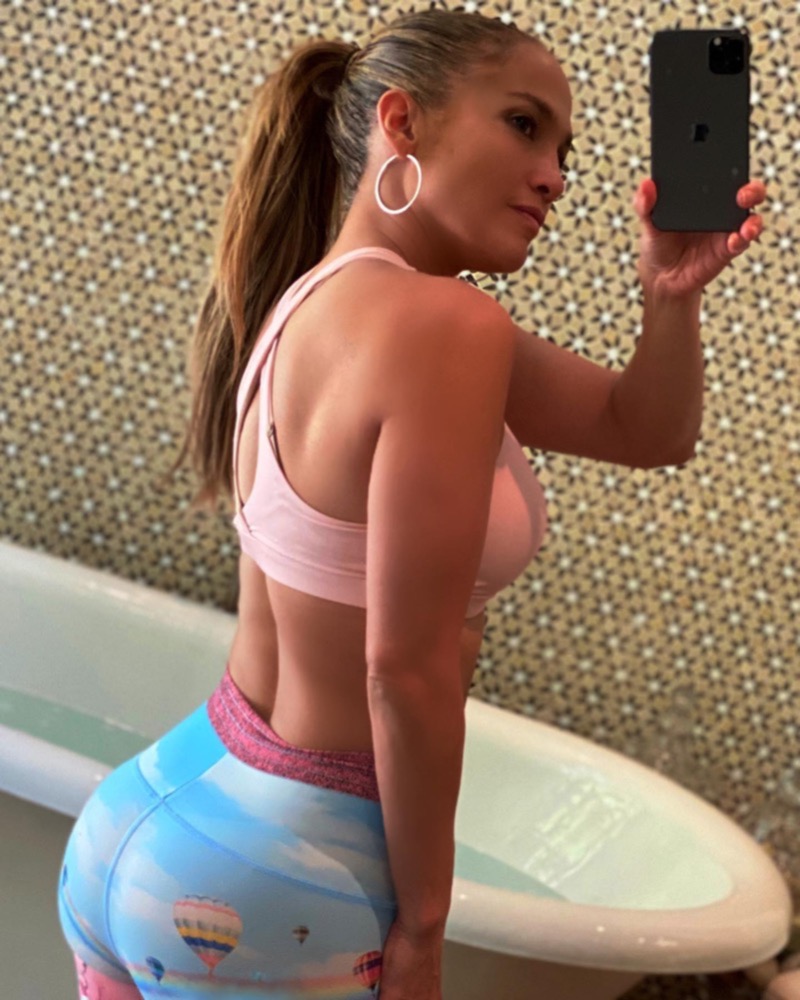 I Asked J.Lo's Trainer for His Very Best Fitness Tips
I Asked J.Lo's Trainer for His Very Best Fitness TipsGunnar Peterson has thoughts on how to get moving this season.
By Kia Topps
-
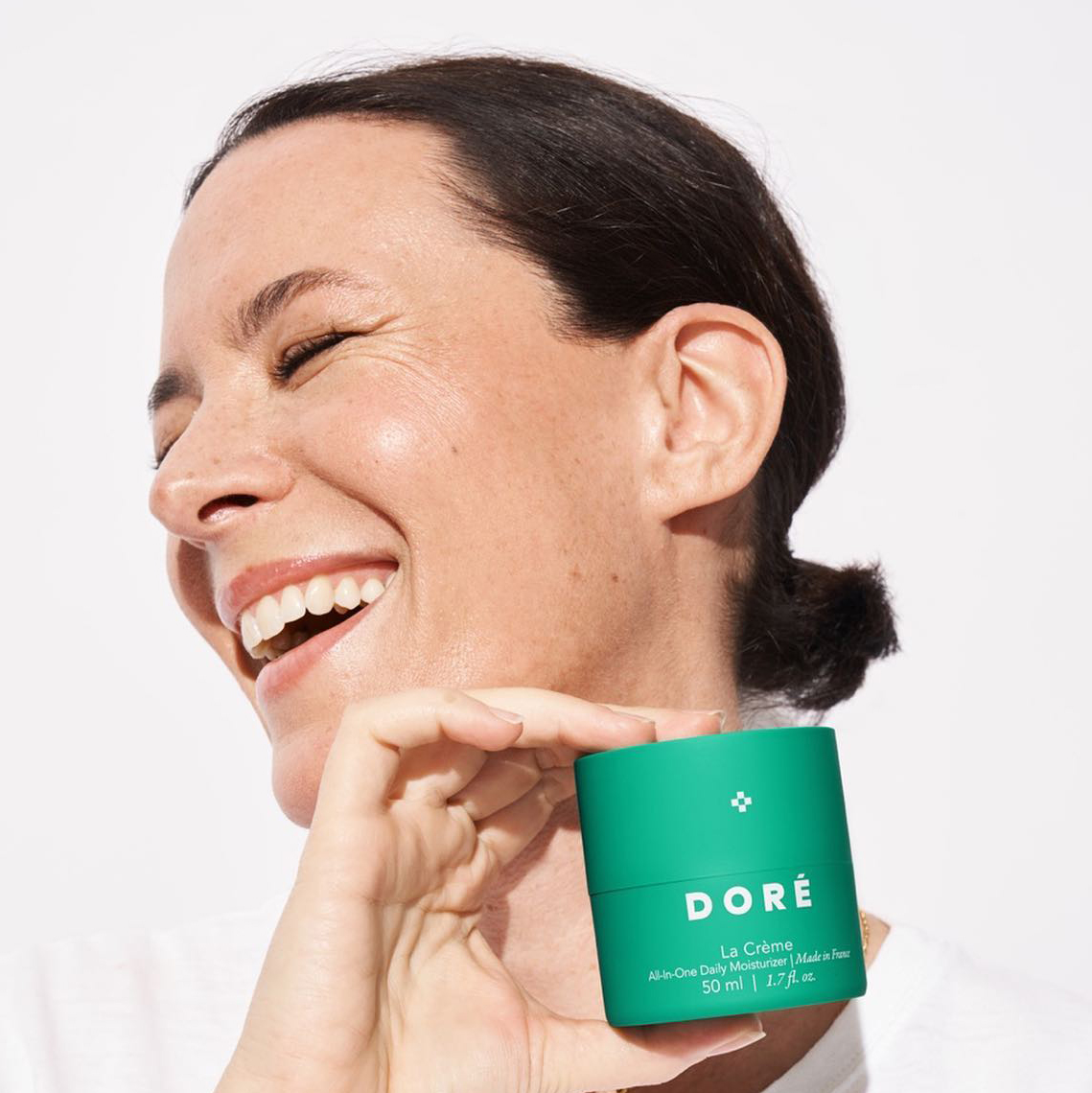 This Style Influencer Turned Founder Shares Her Favorite Ways to Start the Day
This Style Influencer Turned Founder Shares Her Favorite Ways to Start the DayA morning routine from London.
By Candice Aman
-
 13 Products That Will Step Up Your Self-Care Game From Home
13 Products That Will Step Up Your Self-Care Game From HomeGet that glow from within.
By Natalie Gray Herder
-
 These 8 Foods Are the Worst for Rosacea—Here's What to Eat Instead
These 8 Foods Are the Worst for Rosacea—Here's What to Eat InsteadControl those flare-ups.
By Sarah Yang
-
 If You're Super Stressed Out, These 17 Things Can Make You Feel Better
If You're Super Stressed Out, These 17 Things Can Make You Feel BetterTry them.
By Sarah Yang
-
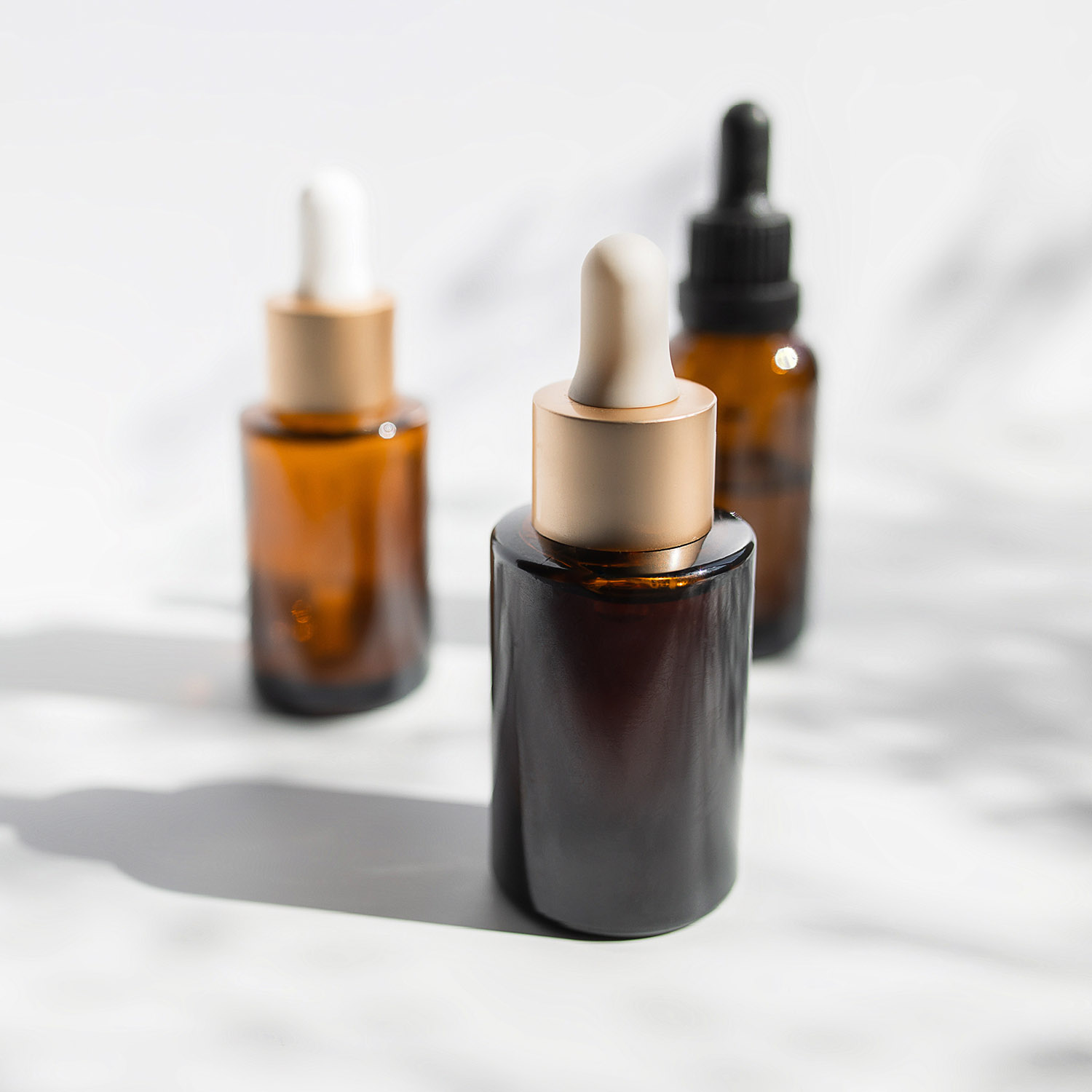 These Essential Oils Will Relieve Your Stress ASAP
These Essential Oils Will Relieve Your Stress ASAPBreathe in. Breathe out.
By Sarah Yang
-
 I Host a Mental Health Podcast—Here Are 5 Important Things I've Learned From It
I Host a Mental Health Podcast—Here Are 5 Important Things I've Learned From ItGive Been Better… HBU? a listen.
By Sarah Yang
